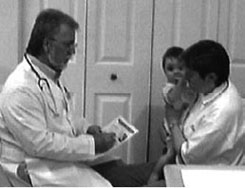 |
|
 |
| Get Smart: Know When Antibiotics Work |
|
 |
| Home > Healthcare Providers > Practice Tips |
 |
|
 |
Make promoting appropriate antibiotic use part of your routine clinical practice
|
 |
Practice Tips |
When parents ask for antibiotics to treat viral infections:
- Explain that unnecessary antibiotics
can be harmful.
- Tell parents that based on the latest evidence, unnecessary antibiotics CAN be harmful, by promoting resistant organisms in their child and the community.
- Share the facts.
- Explain that bacterial infections can be cured by antibiotics, but viral infections never are.
- Explain that treating viral infections with antibiotics to prevent bacterial infections does not work.
- Build cooperation and trust.
- Convey a sense of partnership and don’t dismiss the illness as “only a viral infection”.
- Encourage active management of
the illness.
- Explicitly plan treatment of symptoms with parents. Describe the expected normal time course of the illness and tell parents to come back if the symptoms persist or worsen.
- Be confident with the recommendation to use alternative treatments.
- Prescribe analgesics and decongestants, if appropriate.
- Emphasize the importance of adequate nutrition and hydration.
- Consider providing “care packages” with nonantibiotic therapies.
- Create an office environment to promote
the reduction in antibiotic use.
- Talk about antibiotic use at 4 and 12 month well child visits.

The AAP Guidelines for Health Supervision III
(1997)
now include counseling on antibiotic
use as an integral part of well-child care.
- Start the educational process in the waiting room.
- Involve office personnel in the educational process.
- Reenforcement of provider messages by office staff can be a powerful adjunct to change patient attitudes.
- Use the CDC/AAP pamphlets and principles to support your treatment decisions.
- Provide information to help parents understand when the risks of using antibiotics outweigh the benefits.
|
|
|
|
| |
| |
Date: March 2, 2006
Content source: National Center for Immunization and Respiratory Diseases / Division of Bacterial Diseases |
|